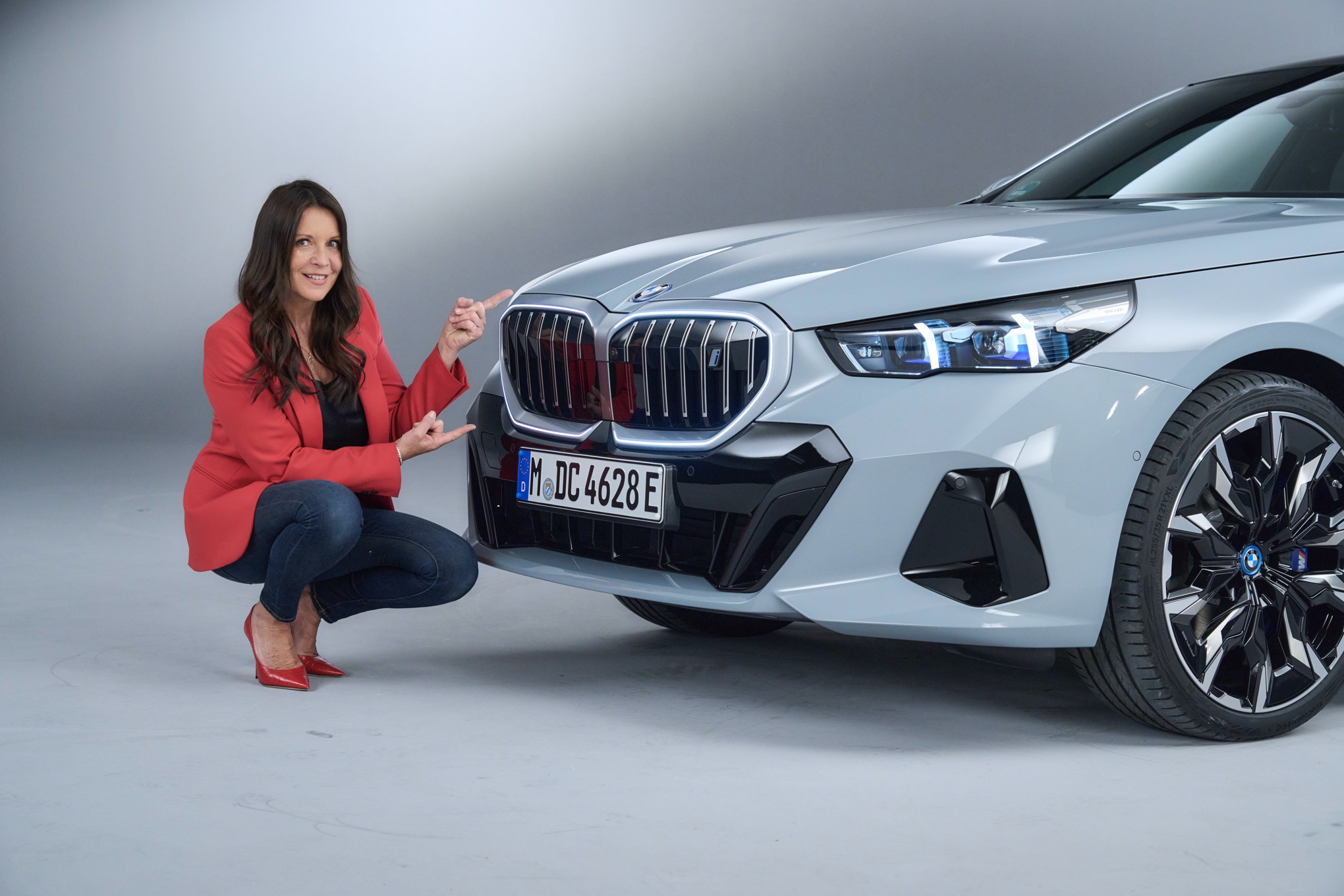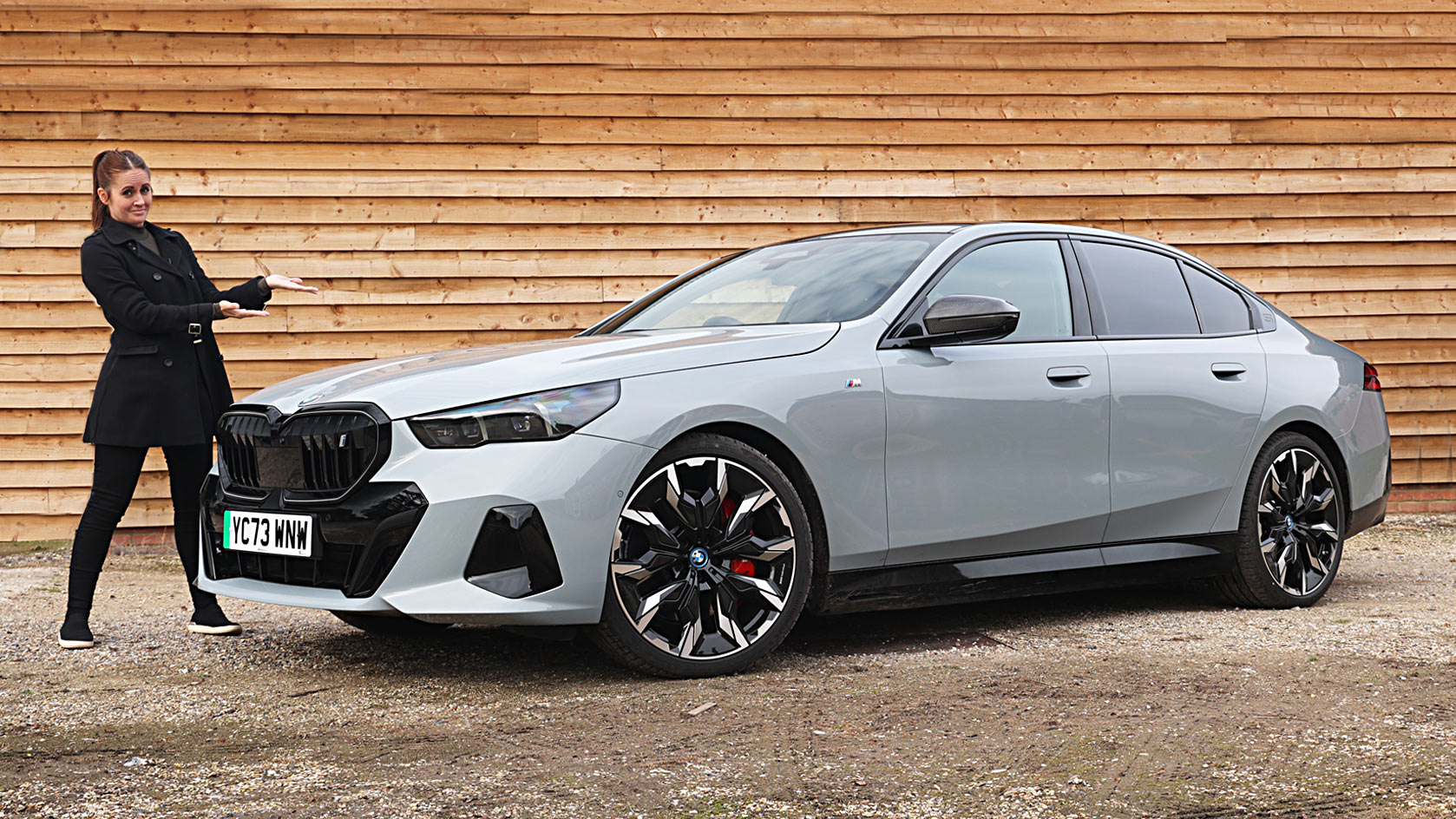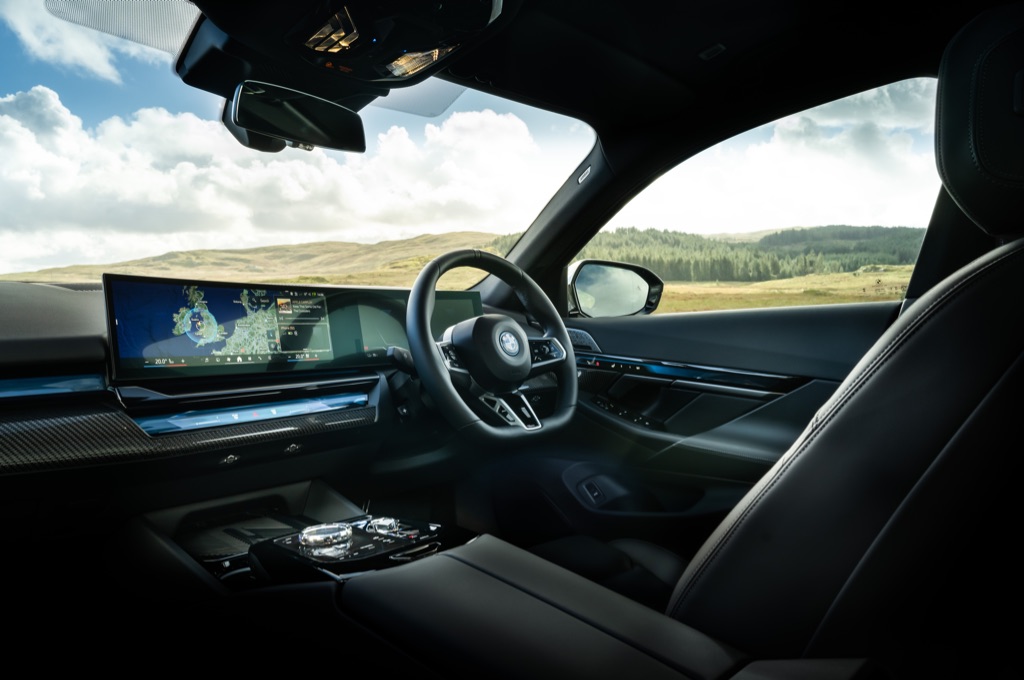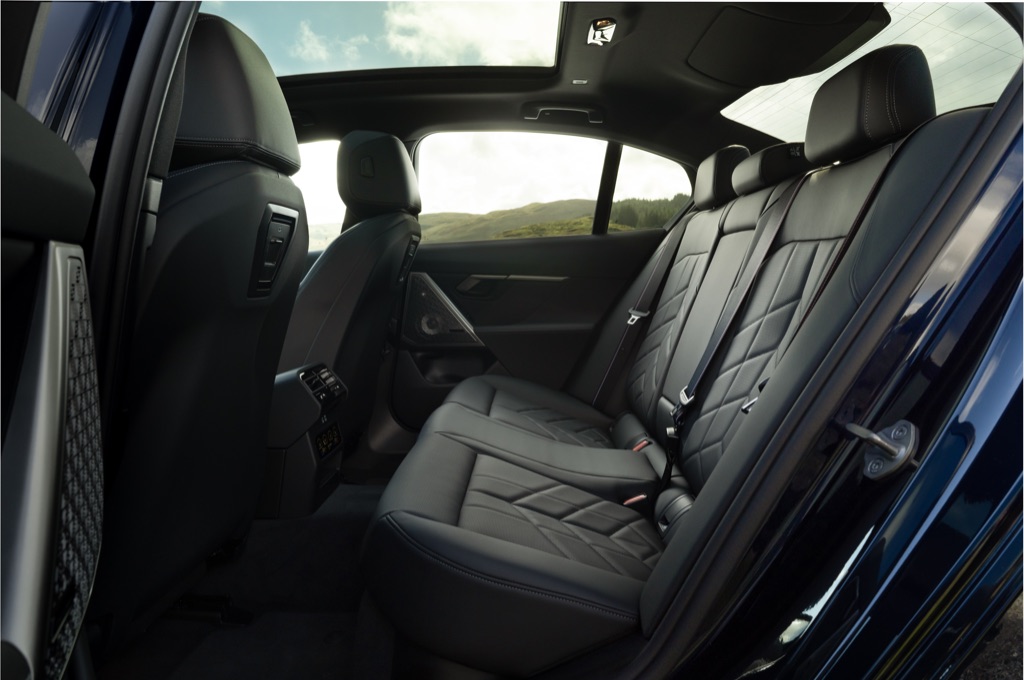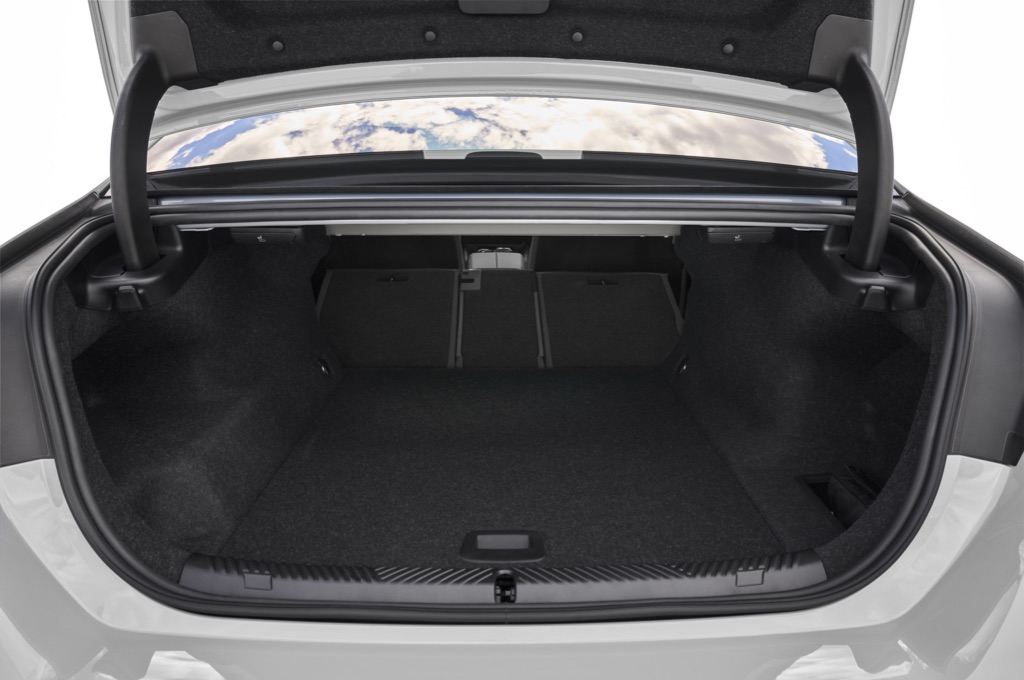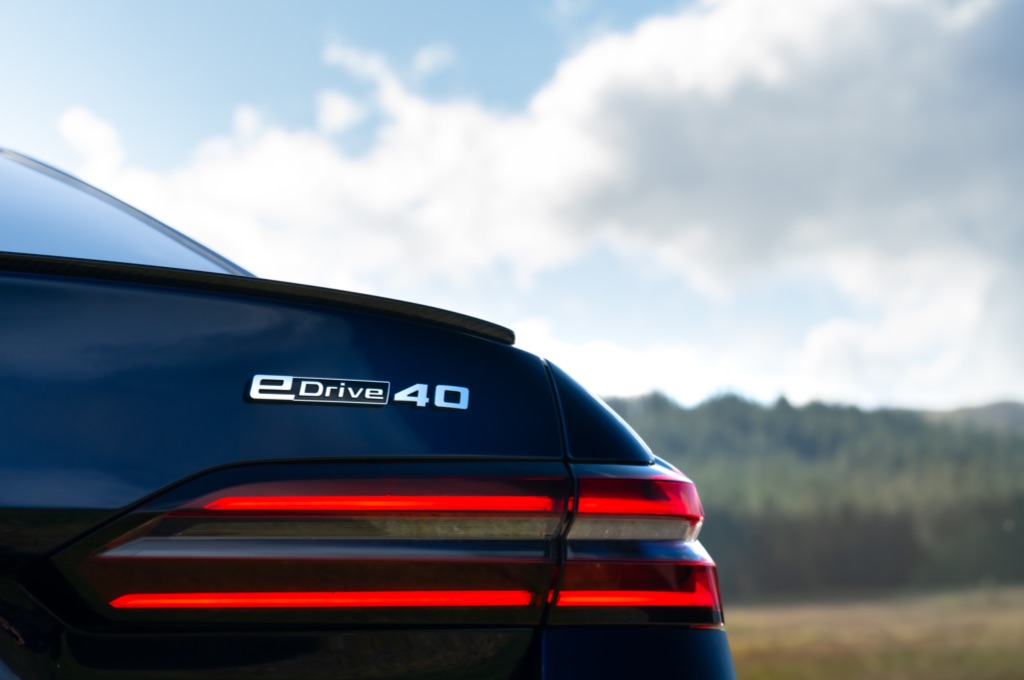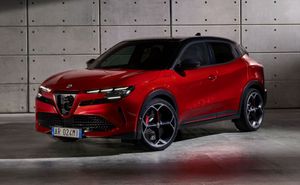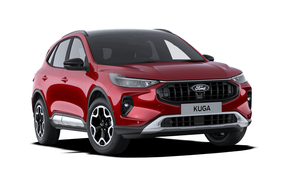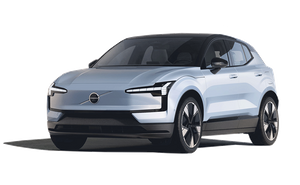Dimensions, design and practicality
The BMW i5 is a large, electric executive saloon; bigger and more luxurious than smaller, sportier BMW i4, if not quite as big and lavish as the BMW i7 limousine. It looks very similar to the standard BMW 5 Series, which is no surprise as it is just that - a version of the new ‘G60’ BMW 5 Series, with an 81.2kWh lithium-ion battery and new-generation electric motor powertrain shoehorned into the ‘CLAR’ platform that also underpins the 2-Series and many other BMW models. A variety of plug-in hybrid and mild hybrid 5 Series models will arrive in 2024, but only the pure electric version gets the i5 badging.
Which isn’t to downplay the BMW i5’s impressive tech and features, but rivals such as the Audi e-tron GT and Mercedes EQE both get bespoke chassis developed exclusively for an electric powertrain. If the i4 and i7 are anything to go by, this won’t stop BMW from proving that a shared platform can still underpin a class-leading EV.
At 5.1-metres long, and with a wheelbase of nearly 3.0-metres, the BMW i5 is a fraction longer than the Audi e-tron GT and Mercedes EQE, but offers the best practicality of the lot. There’s loads of space up front, while rear head- and legroom are usefully better than in the Merc EQE. The boot is a really good size, at 490 litres, and the saloon boot opening gives fairly wide access to the long boot space. The seats fold in a 40/20/40 split to leave a smooth, but sloped extended luggage space – but, it being a saloon, the boot opening is letterbox-shaped, and longer items will obviously have to fed all the way through the opening left by the folded seats, too. If that sounds like it’d be a problem for your luggage-heavy life, don’t forget to look at the BMW i5’s SUV rivals – which include the Audi Q8 e-tron, Mercedes EQE SUV, and even BMW’s own BMW iX3 and iX SUVs. Or, wait for the BMW i5 Touring that’s rumoured to be arriving very soon…
The BMW i5’s cabin design and perceived quality are likely to be one of the biggest selling points. Even in a class that’s full of super-plush finishes and smart design, the i5 feels a bit special with it’s wrap-around ambient-lit interior trim inserts, and – if you option it – crystal-like switches and rotary controller. As standard, the materials are all vegan, too, or you can option real Italian cow-based leather, if you wish.
The seats are super-comfy and can also be had with a massage function, and it all feels exceptionally classy and – inside and out - a bit more conventional than the Merc EQE. For many, it will be seen as a good thing that the BMW has a few more buttons and just feels a bit less futuristic and more familiar in its dash layout, but whether you favour that or whether you embrace the minimalist, tech-first appearance of others is very much a matter of opinion.
And if you do like your EV to have that spaceship-look, then the BMW i5’s conventional saloon shape may not be to your tastes. You can add an illuminated kidney grille, though, which is all very modern and eye-catching, so it’s not like the i5 is without its own style party tricks.
Technology
Having said that the BMW is a less futuristic in appearance than some of its rivals, the huge, single-piece, curved touchscreen is hardly very ‘grandfather clock’. We’re not talking about something that’s out of date, here – the i5’s tech and infotainment is among the best. The central touchscreen gets the latest BMW Operating System 8.5, which in non-geek speak means that you have configurable shortcuts on the home screen, sharp graphics and a quick-responding, 14-9-inch screen, as well nav with charger-search function, wireless Apple CarPlay and Android Auto.
You do have to take some time to get used to the system, though. Even with the iDrive rotary controller and physical shortcut buttons down by your elbow (a feature that we find really useful for easy screen control when you’re driving) the sub-menus that you fall into when you want to access the vehicle or system settings is quite confused with a huge array of small icons. It’s also odd that, when you select a new drive mode from the ‘My Mode’ button, the screen presents a huge, artistic display that’s very lovely, but that doesn’t then go away unless you tell it to.
It's not always the most intuitive infotainment system, then, but to be honest it’s still a little easier to use than the huge iPad-style touchscreen in the Mercedes, and even the screens in the Audi and Porsche Taycan need a similar amount of learning before you can feel confident using them when you’re driving. Complex as it can be, then, with its rotary controller and usefully accurate ‘natural’ voice control the BMW’s is still one of the best systems in the class. We particularly like that you can ask it to turn the standard lane-keep assist system on- and off, which it did accurately every time we asked; useful, as every manufacturer’s lane-keep assist systems can actually be very unhelpful on narrow, rural roads that are common across the UK.
The BMW i5 get adaptive regenerative braking as standard, which responds to upcoming junctions and changes in speed limit as well as to vehicles that are in front of you. More than that, there’s a new semi-autonomous drive system that doesn’t only brake, accelerate and steer to keep you in the lane, but will also steer to change lane and merge for you, rather like a Tesla has been able to do for some years. However, while a Tesla requires you to use the indicator stalk to confirm a lane-change, the BMW will do it with ‘eye confirmation’ from the driver, as the car tracks the driver’s eye movements and responds when the driver has checked the mirror to confirm that the manoeuvre is safe. We haven’t had a chance to try it yet, so can’t comment on what it’s like in practice. Regardless, it’s worth pointing out that this – and any driver assist system currently in use - is still only semi-autonomous, and the driver must still be in charge at all times. We’re not yet at the point where cars can truly drive themselves…
Although, having said that, the BMW i5 can also be had with a remote parking assistant that means you can park it using your connected phone app. The theory is that you can then park in tight spaces that would make it difficult to get in- and out of the car. You can stand up to 200m away and watch, panicking quietly and wondering why you didn’t just look for a bigger parking space or buy a smaller car, while the BMW i5 (hopefully) parks itself. Perhaps more useful and less anxiety-inducing to most drivers, is that the BMW can also park itself while you’re in the car, and it’ll learn how you like to park in routinely used spots, so it can learn how you like to park on your driveway, for instance.
Battery, range and charging
The BMW i5’s 81.2kWh lithium-ion battery is good for an official WLTP range of up to 357 miles in the rear-wheel drive eDrive40, or up to 320 miles for the dual-motor, all-wheel drive M60. That’s not bad at all – it’s better than the Tesla Model Y or Audi e-tron GT can manage, but it’s a fraction less than the Mercedes EQE’s claimed WLTP of up to 410 miles. We’d expect to see a real-world range of around 270- 340 miles from the BMW i5 eDrive 40, depending on when and how you’re driving it; the standard integrated heat pump should help to keep winter range on the i5 up to a good standard, too.
Predictably, the more powerful, dual-motor i5 M60 has a shorter range, but it’ll still do up to 320 miles WLTP range despite also being able to smash through a 0-62mph sprint in 3.8sec.
Rapid charging on both models peaks at 205kW, meaning that you’ll have a 10-80% charge in around half an hour, or a 100 mile top-up in just over 10 minutes, if you plug into a powerful enough rapid charger. AC charging (which is what you’re doing when you plug into a home car charger or any slower charger that uses the Type 2 socket rather than the bigger, CCS rapid charging socket) is up to 11kW as standard or can optionally be dialled up to 22kW. Useful if you’ve got a three-phase electrical system that can support an 11- or 22kW AC charger – you normally only find these in industrial settings, or possibly big office or car park complexes. For most UK residences, a 7kW home charger will be the fastest charger that your home can support, and that’ll fully charge the BMW i5 in around 13 hours.
Driving
The BMW i5 is a real joy to drive. With standard air suspension, it does a brilliant job of ironing out patchy road surfaces, yet even the eDrive40 feels pleasantly well-balanced and fun to drive. With 335bhp going to the rear wheels via a new, fifth-generation electric motor that’s more efficient than before, the i5 eDrive40 will do 0-62mph in 6.0sec, which feels about spot-on. More than rapid enough for swift merges or overtakes, and to be satisfying on a decent road, but also unintimidating and easy to modulate. Just about ideal for making best use of the adaptive air suspension, which does let the BMW roll a bit (this is a 2.2-tonne car, after all) but always feels unflappable and responsive.
It’s just peachy to drive, the i5, whether you’re just covering miles on the motorway in Eco mode, or enjoying a fun road in Sport mode, the BMW feels like it’s absolutely at home. Refined, and more comfortable yet also more balanced than many rivals, including the Tesla Model Y and Mercedes EQE.
The M60 gets a sportier adaptive air suspension setup and four-wheel steer as standard, which you notice mostly from springier vertical damping as the car soaks up undulations and bumps in the road. It still does a surprisingly good job over coarse surfaces and sharp-edged bumps, while the body feels more tightly tied down and the slimmer-rimmed M Sport steering wheel allows more sense of feedback from the wheels.
Some four-wheel steer settings can make a car feel a touch nervous as it gives a sense that the car is turning-into corners really aggressively, but the BMW’s is well sorted and you don’t notice anything other than an assertive, confident cornering manner. It’s all very intuitive and natural-feeling; easy to enjoy without feeling overly assisted and nannied by electronic gubbins. There’s even a rather comical ‘Boost’ paddle on the M60, that you can pull for 10-seconds of the full 593bhp and 605lb ft, for 0-62mph in 3.8sec. The rest of the time you ‘only’ get 510bhp and 586lb ft.
However, we’d stop short of saying that the BMW i5 is as good to drive as the Porsche Taycan, or even the Audi e-tron GT quattro. Both of these rivals are sports saloons, rather than the more upright, comfort-oriented executive saloon that the BMW i5 is, and that does show in that the Audi, and even more so the Porsche, are more agile and fun. After all, the Porsche Taycan, even in the lower-spec models that you’ll have to settle for if you want to keep it to a similar price point to the BMW i5, remains one of few true ‘enthusiast’ EVs. The payoff is that there’s not as much space in the Audi or Porsche, and they’re more expensive than the BMW i5 when you factor in performance and equipment, so there is a compromise.
As a blend of executive slicker and occasional country-road thriller, the BMW i5 strikes a fantastic happy medium – even in the more modest eDrive40 that we favour.
Pricing and availability
The BMW i5 is available to order now, with deliveries due to start before the end of 2023. Equipment is fairly generous even on the eDrive40, which is currently only offered in M Sport trim and comes with 19-inch alloy wheels, vegan leatherette interior, the full curved touchscreen infotainment system, heated seats, climate control and more.
However, most will want to add the Technology Pack with its head-up display, upgraded ‘natural’ voice command and semi-autonomous parking aid, or the Technology Pack Plus goes another step further with the Driving Assistant Professional for semi-autonomous lane-change assist tech and more. The Comfort Access pack, that brings keyless entry and allows you to use your phone as the key, a heated steering wheel, and two tablet holders and USB-C charging ports in the rear seats will also be a popular option – as will the panoramic glass roof. While you can get away without adding any options to the BMW i5 eDrive40, and still have a very lovely car, most transaction prices will likely be close to £80,000.
The i5 M60 is better equipped as standard, but items like the head-up display, Harman/Kardon sound system upgrade and the Driving Assistant Professional will cost extra, so most will end up costing six figures.
Ultimately, the BMW i5 is hardly cheap - especially if you consider ‘less premium’ alternatives like the excellent (if smaller) Kia EV6 – but it’s in line with what you’ll pay for direct rivals like the Mercedes EQE.





.png)



